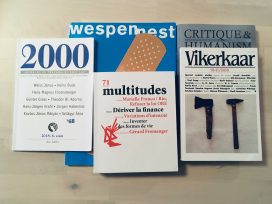Abstracts Multitudes 18 (2004)
DIDIER DEBAISE
QU’EST-CE QU’UNE PENSÉE RELATIONNELLE ?
Modernity, in Simondon’s view, is constituted on the basis of a paradigm that runs through all the realms of experience: being-individual. It could thus be defined as a set of operations, techniques, and forms of knowledge that seek to extract the individual dimensions of that which, in reality, appears as essentially attached, intertwined and mutable. Therefore one of the possibilities to overcome certain problems that have accompanied modern thinking (involving knowledge, experience, the social) could be found in what we call “relational thinking,” where the relation holds a central position.
YVES CITTON
SEPT RÉSONANCES DE SIMONDON
Why read Simondon today? Seven lines of inquiry are sketched out here, seven problematics whose construction Simondon invites us to explore, seven twists away from the dominant political treatment of questions concerning the individual, the social body, the contract, identity, the affects, heterogeneity.
PAOLO VIRNO
LES ANGES ET LE GENERAL INTELLECT. L’INDIVIDUATION CHEZ DUNS SCOT ET GILBERT SIMONDON
More than any other philosopher, Duns Scotus and Simondon both gave extensive consideration to the relation between what is primarily common and what is primarily singular. Pointing to certain resonances between their ideas can help us to develop a theoretical model to decipher the mode of being of the contemporary multitude. This article deals with: 1. The critique that Duns Scotus and Simondon address to everyone who believes that the matter-form pair can account for the process of individuation; 2. The gap separating the notion of the “universal” from that of the “common”, and therefore, the need to precisely define the ontological and logical status of the “common” without any surreptitious use of categories linked to the “universal; 3. The paradoxical relation – involving both addition and subtraction – between the individuated individual and “common nature”; and 4. The question of angels (are they or are they not individuals?), a source of enduring fame in school textbooks for Duns Scotus, re-examined here in the light of Simondon’s concepts of “transindividuality” and of “collective individuation”.
JACQUES ROUX
PENSER LE POLITIQUE AVEC SIMONDON
Simondon’s thinking of individuation is not directly concerned with any political application. Yet, through notions such as metastability, associated environment, centrality, or even ethics, the philosopher opens up pathways for a fresh examination of the processes of social transformation and the question of living together. Simondon’s writings, which complement John Dewey’s approach to the public, allow us to understand the political positively, as reflexive experimentation with the transindividuality of shared beings.
ISABELLE STENGERS
RÉSISTER À SIMONDON ?
In this article, Isabelle Stengers questions the sudden receptivity that now accompanies the rediscovery of Simondon’s thought. Rejecting an aura of piety which threatens to surround his work, she warns us not to take “transindividuality” for an empty word, nor for a theoretical panacea; instead we should see it as an immanent vector of perplexity, an invitation to construct experimental practices and collective agencies – a tool for empowerment.
BERNARD ASPE & MURIEL COMBES
L’ACTE FOU
After a brief survey of the speculative sequence “individuation-transduction-transindividuality” which structures Simondon’s thought, the authors focus their attention on one of its paradoxical limits: the isolation of a writer who devoted his life to thinking in terms of relations. They suggest that the type of action towards which Simondon directed his efforts could not fit with the way he characterized transindividual experiences. By pursuing the path of a speculative thinking incapable of constituting a collective form of transindividuality, Simondon became caught in a logic which he himself described as that of “the act of madness.”
ALBERTO TOSCANO
LA DISPARATION. POLITIQUE ET SUJET CHEZ SIMONDON
Is it possible to derive the outlines of a thinking of politics from the writings of Gilbert Simondon? We will sketch an affirmative response by focusing our attention on three aspects of Simondon’s philosophy: 1. the manner in which the concept of Nature or the pre-individual displaces the debates over the relationship between political action, human nature and biological capacity; 2. the importance of the excess of “subject” over “individual” as the matrix of a politics of the transindividual; 3. the possibility of envisaging the notion of disparation, especially through its Deleuzian reading, as an essential contribution to a political philosophy of difference, that is, to a non-dialectical thinking of construction and conflict. We will end with a consideration of the limits of Simondon, limits in our view concentrated in the equivocal and irenic notion of “culture” or “technical culture.”
EMILIA M.O. MARTY
SIMONDON, UN ESPACE À VENIR
Gilbert Simondon’s work is devoted to the act of knowledge as a specific human experience, common to all the specialized fields. It is a departure toward infinity, an opening to nature, which emerged as soon as philosophy was discovered in Greece. This movement of individuation is rooted in the pre-individual, in the flux of life.
OLIVIER BLONDEAU
DES HACKERS AUX CYBORGS : LE BUG SIMONDONIEN
Cutting against the technophobic grain of philosophical traditions inspired by Heidegger and Habermas, Simondon’s book on “The mode of existence of technical objects” invites us to find a positive way beyond the critique of modernity. He offers a framework particularly appropriate for understanding the stakes of the “techno-nature” which has been accepted and appropriated by the hacker ethic, and for inquiring into its corresponding forms of political subjectivity. The unity of producer, technical object and user, which for Simondon is part of the transindividuality of the machine, suggests a fresh treatment of the questions of the expressiveness of code, of open source, and of the constitution of connectionist collectivities.
DIDIER DEBAISE
LE LANGAGE DE L’INDIVIDUATION (LEXIQUE SIMONDONIEN)
After a few general remarks on the theoretical stakes of Simondon’s lexicological inventions, a lexicon is offered to help the reader enter fully into his philosophy. Quotations are used to discuss and define six key notions: metastability, transduction, hylemorphism, “disparation”, singularity and the transindividual.
SARI HANAFI
SPATIO-CIDE, REFUGIÉS, CRISE DE L’ÉTAT-NATION. VERS UN ÉTAT PALESTINIEN EXTRATERRITORIALISÉ
Sari Hanafi analyzes the situation of the Palestinian population and the occupation of the West Bank and Gaza, advancing the concept of “spatiocide.” This policy of the Israeili state, seeking the “voluntary transfer” of the Palestinians, is carried out by biopolitical means, under states of exception. For the author, a classical Palestinian nation-state would be unable to solve the inevitable problem of refugees. He proposes an original solution: an extraterritorialized nation-state.
PASCAL HOUBA
TRANSHUMANISER ET ORGANISER LES MULTITUDES
Pasolini’s protean oeuvre focuses particularly on lives outside the conventional class system and its norms. This text examines how one might envisage the organization of the multitudes in light of the practices developed by Pasolini to treat these singular forms of life. It reveals the ethical coherency of the “free indirect discourse” that Pasolini deploys in the context of the ideological and linguistic normalization that emerged from Italian fascism and neocapitalism.
ALAIN NAZE. PASOLINI
UNE ARCHÉOLOGIE CORPORELLE DE LA REALITÉ
Focusing on Pasolini’s written work, the article tries to bring out a kind of minor language, the embodied language of popular, archaic and peasant worlds. For if Pasolini attempts the representation of reality by reality in his films, it can also be noted that in his poems, novels and stories, he was already on the track of reality itself. Consequently, Pasolini’s love for this world predating industrial and consumer devastation is first of all a love for the languages that reveal it through a system of inter-expression, placing the bodies at the center and making the spoken language itself into an element of reality – unlike official Italian, which bears witness to the loss of reality through consumerist standardization.
MICHAEL HARDT
L’EXPOSITION DE LA CHAIR CHEZ PASOLINI
Developing Pasolini’s thoughts in the poem “Crucifixion”, Michael Hardt sees Christ’s passion as the very model of the offering of the flesh, of the pagan affirmation of the continuity between immanence and transcendence. Through the eroticism of his exposure on the cross, Christ invites us to unite in the flesh, like him. He makes the people watching him share the experience of the flesh, its suffering and its joy, and thereby takes away his jailers’ power to corrupt it. Thus he empowers himself and everybody with love.
PIERRE OLIVIER CAPÉRAN
LA MESURE DU FANTASME
Beginning with the hypothesis that the cinema offers a yardstick for fantasy by actualizing it in a filmic space and time, the text works out or “operates” Pasolini’s Decameron by noting the contaminating effects of foreign bodies on individualized, essentialized, “own” bodies. Displacing the operation onto the structure of the film itself, it analyzes the dispersion of the cosmological order of narratives and the emergence, amidst the narrative sequences, of a continental discontinuity of bodies and spaces. A cinema of materials and postures, the Decameron is a cinematographic materialism, expropriating bodies, multiplying them.
RENE SCHÉRER
L’ENFER DE L’HÉDONISME
Even if it is indeed impossible to consider Pasolin’s Salò as an illustration of Sade’s One Hundred and Twenty Days of Sodom, we should not treat the film as merely a schematization or a betrayal of the book, as one often hears. Pasolini uses the “reference” to Sade as a “tool,” in all its ambiguity, with which to demonstrate and dismantle the consequences of the paradoxical logic of the Enlightenment, i.e. its utilitarian and hedonistic ethics. Sexuality considered as pure consumption becomes the device and the instrument of power and destruction. Salò’s target is not fascism in its historical form, but rather its derivative, still invisible form in consumer society, which leads to the collapsing of the body and eros in the language of communication and the integral transparency of affects.
TONI NEGRI & MICHAEL HARDT
MULTITUDE : GUERRE ET DÉMOCRATIE À L’ÉPOQUE DE L’EMPIRE (BONNES FEUILLES)
In these selections from their new book, entitled Multitude: War and Democracy in the Age of Empire, Toni Negri and Michael Hardt focus on the notion of “multitude,” in the face of various critiques that followed the publication of Empire in 2000. They also look at the new possibilities for organizing in response to the war regime that has been installed since September 2001.
FLORENT LATRIVE
DU BON USAGE DE LA PIRATERIE. CULTURE LIBRE, SCIENCE OUVERTE
What is a pirate? In this excerpt from a forthcoming book, Florent Latrive uses a series of historical examples to show that the pirate copy, as a legal and artificial construction, is a notion that varies in time and space. Who still remembers that as recently as 1976, the Hollywood majors dragged a diabolical technological invention, the tape deck, into the courts, and proved that if everyone could freely pirate the films broadcast over television, the entire film industry would soon bite the dust?
PHILIPPE ZARIFIAN
PRODUCTIVITÉ, ÉVÉNEMENT ET COMMUNICATION DANS LE POST-FORDISME. SUR LE LIVRE DE CHRISTIAN MARAZZI : ET VOGUE L’ARGENT
In this review of Christian Marazzi’s book Et vogue l’argent (Money Sails On), the discussion concentrates on three questions which are central to the analysis of post-fordist capitalism: 1. Is there really a dissociation between financial investment and productive investment, and should one not rather recognize a new capitalist stratum constituted by the association between the managers of investment funds and the top-level administrators of the great productive firms? 2. Does the notion of the mass worker, as used by Marazzi, not tend to both to underestimate the productivity of the Taylorist worker and to overestimate his political activism? And finally, 3. Should the focal point of emergent productivity not be grasped as much in terms of the event (and of the inventive response to events) as in terms of linguistic communication?
Published 20 September 2004
Original in French
Contributed by Multitudes © Multitudes
PDF/PRINTNewsletter
Subscribe to know what’s worth thinking about.



